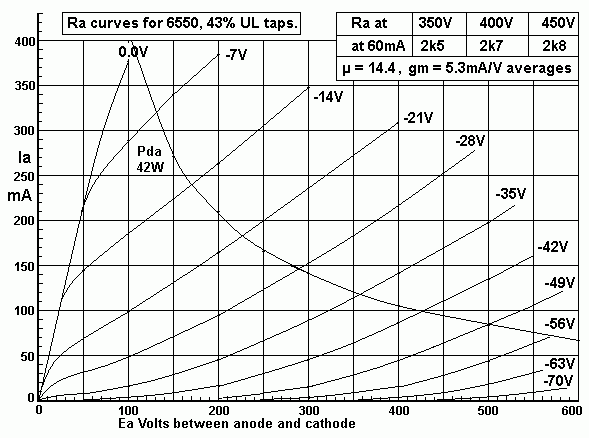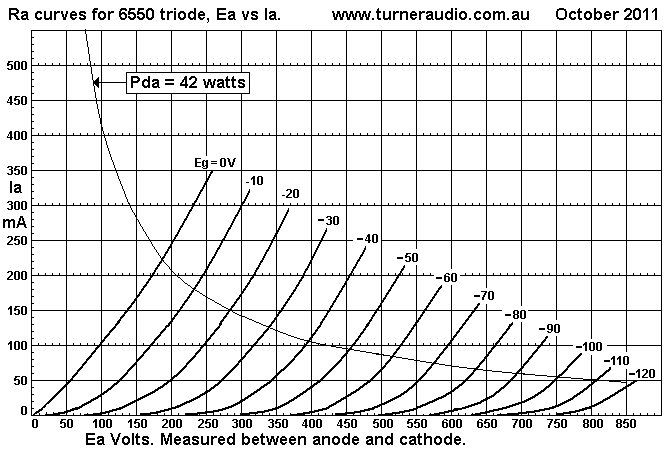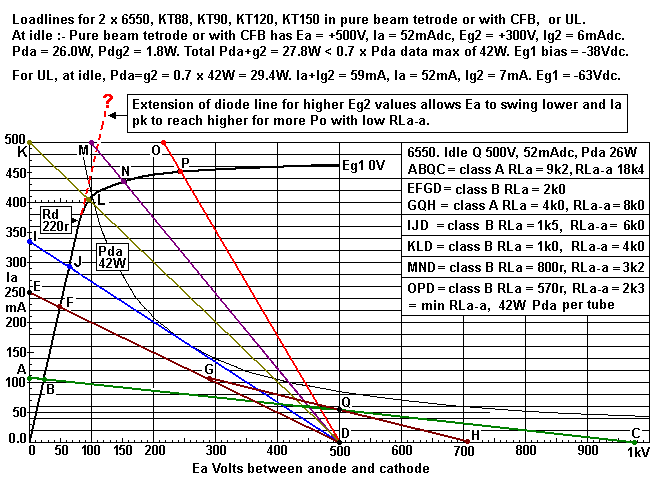
| Load |
RLa-a |
Ea pk minV |
Ea idle | Va pk |
Va rms |
Va-a rms |
Max class AB1 W |
Max class A1 W |
Power quality |
DF |
THD, IMD |
| BQC |
18k4 |
22 |
500 |
478 |
338 |
676 |
0.0W |
24.8W |
Good |
highest |
very low |
| EFD |
8k0 |
50 |
500 |
450 |
318.2 |
636.4 |
50.6W |
10.8W |
Best |
high |
low |
| IJD |
6k0 |
68 |
500 |
432 |
305.5 |
610.9 |
62.2W |
7.9W |
Good |
high |
medium |
| KLD |
4k0 |
95 |
500 |
405 |
286.4 |
572.7 |
82W |
5.4W |
Good |
medium |
high |
| MND |
3k2 |
153 |
500 |
347 |
245.3 |
490.7 |
75.2W |
4.3W |
Poor |
low |
too high |
| OPD |
2k3 |
242 |
500 |
258 |
182.4 |
364.8 |
58.0W |
3.1W |
Disgusting |
low |
Horrible |

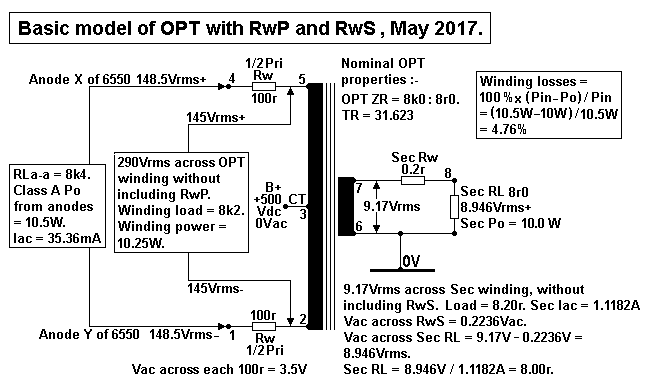
| Tube type
No |
Max Pda for 1 tetrode or pentode, W |
Ea at idle Vdc |
Iadc at idle, 1 tube, mAdc |
Pda Idle W |
RLa-a for max Pure Class A 1.9 x Eadc / Iadc for 1 tube. Po, PP max W |
RLa-a Nominal class AB1 0.8 x Ea / Iadc. Po, PP max W |
RLa-a minimum class AB1 0.4 x Ea / Iadc Po, PP max W |
| 6550, KT88 |
42W |
500 |
50 |
25 |
19k0 24W | 8k0
50W |
4k0
82W |
| 6550, KT88 |
42W |
425 |
60 |
25 |
13k5
24W |
5k7
48W |
2k8
79W |
| 6550, KT88 |
42W |
350 |
72 |
25 |
9k3
24W |
3k9
46W |
2k0
76W |
| KT90 |
50W |
500 |
60 |
30 |
15k8
28W |
6k6
56W |
3k3
90W |
| KT90 |
50W |
425 |
70 |
30 |
11k5
28W |
4k9
53W |
2k5
86W |
| KT90 |
50W |
350 |
86 |
30 |
7k7
28W |
3k3
50W |
1k7
82W |
| KT120 |
60W |
500 |
72 |
36 |
13k2
34W |
5k6
66W |
2k8
92W |
| KT120 |
60W |
425 |
85 |
36 |
9k5
33W |
4k0
63W |
2k0
84W |
| KT120 |
60W |
350 |
102 |
36 |
6k5
32W |
2k8
60W |
1k4
80W |
| EL34, 6CA7 6L6GC, KT66 |
27W |
425 |
40 |
17 |
20k0
16W |
8k5
30W |
4k2
45W |
| EL34, 6CA7 6L6GC, KT66 |
27W |
390 | 44 |
17 |
17k7
14W |
7k1
29W |
3k5
44W |
| EL34, 6CA7 6L6GC, KT66 |
27W |
350 |
49 |
17 |
13k6
13W |
5k7
28W |
2k9
43W |
| EL84, 6V6 |
12W |
300 |
27 |
8 |
21k0
7.7W |
8k9
15W |
4k5
19W |
| EL84, 6V6 |
12W |
250 |
32 |
8 |
15k0
7.6W |
6k3
14W |
3k2
17W |
| 6CM5 |
20W |
350 |
42 |
15 |
15k8
14W |
6k7
27W |
3k4
40W |

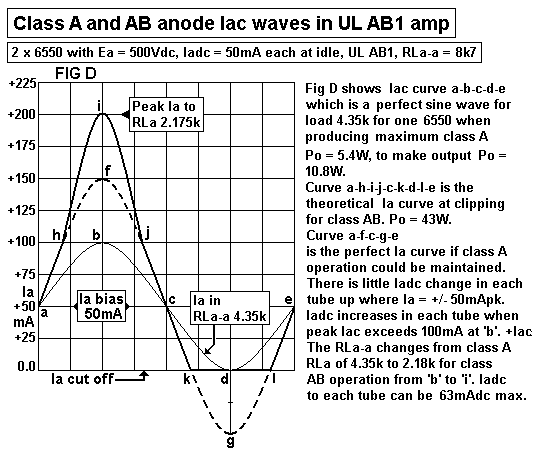
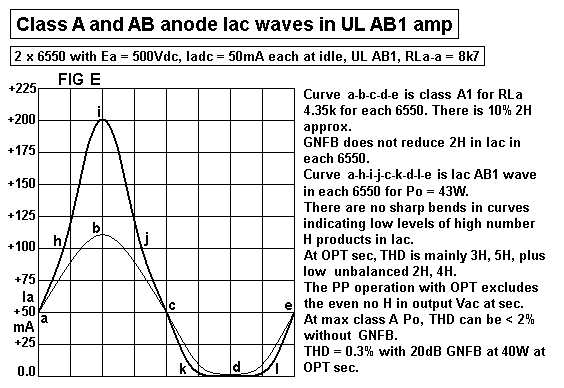

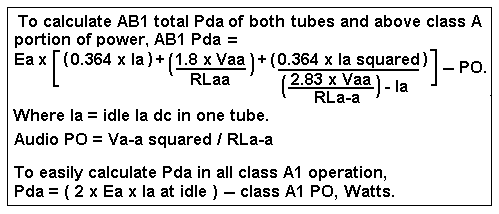
| XX brand name Speaker Nominal Z |
RLa-a OPT ZR 2,000 : 1 TR = 44.72 |
Max class AB1 Po at OPT sec, Watts. |
Max class A Po at OPT sec, Watts. |
OPT winding loss % ( approx ! ) |
THD |
| 2r0 |
4k0 |
72W | 5.0W |
15% |
high |
| 3r0 |
6k0 |
56W |
7.5W |
10% |
high |
| 4r0 |
8k0 |
47W |
10.0W | 7% |
med |
| 6r0 |
12k0 |
33W |
15.0W |
5% |
low |
| 8r0 |
16k0 |
27W |
20.0W |
3.0% |
low |
| 12r0 |
24k0 |
nil |
18.0W | 2.0% |
low |
| XX brand name Speaker Nominal Z |
RLa-a OPT ZR 1,000 : 1 TR = 31.62 |
Max class AB1 Po at OPT sec, Watts. |
Max class A Po at OPT sec, Watts. |
OPT winding loss % ( approx ! ) |
THD |
| 4r0 |
4k0 |
72W | 5.0W |
15% |
high |
| 6r0 |
6k0 |
56W |
7.5W |
10% |
high |
| 8r0 |
8k0 |
47W |
10.0W | 7% |
med |
| 12r0 |
12k0 |
33W |
15.0W |
5% |
low |
| 16r0 |
16k0 |
27W |
20.0W |
3.0% |
low |
| 24r0 |
24k0 |
nil |
18.0W | 2.0% |
low |
| XX
brand name Speaker Nominal Z |
RLa-a OPT ZR 500 : 1 TR = 22.37 |
Max class AB1 Po at OPT sec, Watts. |
Max class A Po at OPT sec, Watts. |
OPT winding loss % ( approx ! ) |
THD |
| 8r0 |
4k0 |
72W | 5.0W |
15% |
high |
| 12r0 |
6k0 |
56W |
7.5W |
10% |
high |
| 16r0 |
8k0 |
47W |
10.0W | 7% |
med |
| 24r0 |
12k0 |
33W |
15.0W |
5% |
low |
| 32r0 |
16k0 |
27W |
20.0W |
3.0% |
low |
| 48r0 |
24k0 |
nil |
18.0W | 2.0% |
low |
